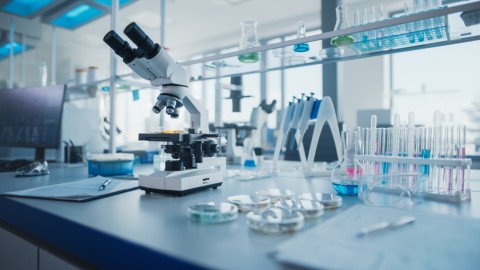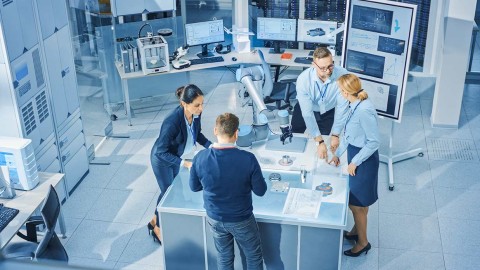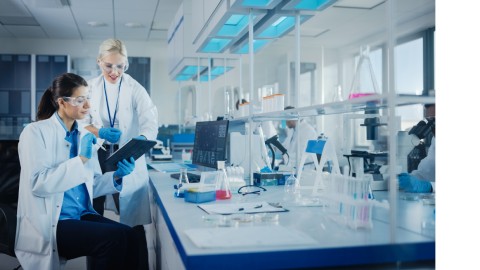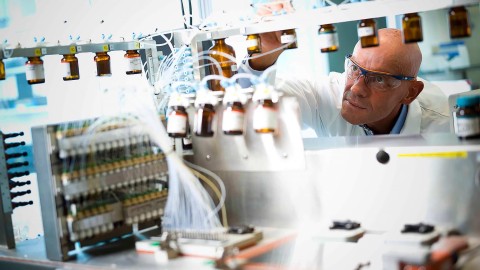03/09/2020
How sustainability and lean new working arrangements have affected the modern laboratory environment
Interview with laboratory experts Sascha Schieber and Frank Pauli
Laboratory design, construction and operation in turbulent times
We are experiencing another industrial revolution. One mainly driven by globalization, digitalization and agile new work models. Thinking has become more interdisciplinary, resulting in even tighter integration of laboratories into companies’ holistic workflows. We talked to Sascha Schieber, Facilities Services, Head of Design and Construction, and Frank Pauli, Facilities Services, Head of Facilities Operation, at Infraserv Höchst about the challenges that current market trends present to laboratory service providers like Infraserv in laboratory design, construction and operation.
Infraserv offers the full range of laboratory services for a wide variety of industries: from laboratory design, construction and operation all the way to end-to-end facility management. Why this all-inclusive approach?
Frank Pauli: Modern-day laboratories place far more complex demands on designers, operators and occupants than they did a mere 20 years ago. Laws and regulations are now much stricter about environmental protection, technical safety, worker health and safety, and dangerous substance handling. The most important rules are the Guidelines for Laboratories published by the Institution for Statutory Accident Insurance and Prevention for the Raw Materials and Chemical Industry (Berufsgenossenschaft Rohstoffe und chemische Industrie – BG RCI).
Sascha Schieber: I’d also like to add that work methods have changed dramatically in recent years. We are more agile and connected than ever before. Interdisciplinary work, particularly in R&D, has introduced entirely new organizational structures in laboratories as well.
Frank Pauli: Good point. Whenever I talk to customers, it’s striking how much their requirements for laboratory work environments have changed in recent years. If we want to effectively and consistently meet these new requirements, we have to adopt a comprehensive approach that considers not just what customers need today, but the laboratory’s entire lifecycle along with prospective changes in requirements.
What are the key considerations in designing a laboratory?
Frank Pauli: One thing is frequently neglected in the initial design phase: You have to start out with a budget that’s appropriate for the basic design of the laboratory. And I’m not just talking about regular laboratory operation, either. You need the foresight to build in enough flexibility to upgrade space and equipment over the facility’s useful life.
Experience shows that laboratories often have to accommodate additional requirements relatively soon after being built. That obviously has some operational relevance: It makes sense to bring the future owner on board during construction so that you can both work on developing a sustainable predictive maintenance program.
Sascha Schieber: It’s also important to break out laboratory and equipment requirements early on in the project. If you make changes down the road, you’ll generally face downtime and huge additional costs if, say, key technologies have not been redundantly designed or your maintenance plans have not been fully approved.
You have to start out with a budget that’s appropriate for the basic design of the laboratory.
Frank Pauli: You learn from experience, too: All the equipment has to be always available while the laboratory is in operation. That’s why it’s important to devote enough attention to seemingly minor details such as ground fault circuit interruption as early as in the design phase. You can extend maintenance cycles by installing twin GFCI sockets, conducting risk assessments or taking other technical measures. A well-thought-out maintenance plan can often save you considerable time and money.
Our first questions are always, “What does the customer really need? What are their laboratory processes?”
Sascha Schieber: It’s important to adapt the basic design to the owner’s needs – from equipment to work processes. Obviously, the design will depend heavily on the customer’s core research focus, but it also has to reflect the space programming, work station standards and interfaces between the laboratory and other departments – all while complying with building codes, health and safety laws, risk assessment findings and hazardous substance regulations. In most cases, you try to build compliance into the design from the start. By the way, I mean not just compliance with laws and regulations, but also with all required certifications – that avoids extra costs for modifications down the road.
Frank Pauli: No matter what else you may do, it always pays to bring in an external service provider like Infraserv who not only knows the pitfalls, technical possibilities, business opportunities and current regulations but can also draw on a wealth of experience with the specific requirements of your industry. Our first questions are always, “What does the customer really need? What are their laboratory processes?”
Sascha Schieber: At this point, we often refer decision-makers and laboratory personnel at the company to our 6 Golden Rules for Laboratory Design , which provide a quick gloss on the factors that you absolutely have to consider in the conceptual design phase. Good laboratory design is about far more than getting the budget right. First, you face the fundamental question of whether you want to rehabilitate an existing laboratory or build an entirely new facility …
Frank Pauli: It’s always best to set up a detailed specification as early as possible in the laboratory design process. That minimizes the risk that you’ll overlook something important. The building code sets out very clear requirements, particularly with regard to life safety and fire protection. If these areas are found to be deficient later on, you might not even be allowed to use the laboratory without first making expensive, time-consuming changes.
The COVID-19 pandemic has been a tremendous challenge for science, research and development but also for day-to-day business operations in most industries. How can Infraserv step in and help as a laboratory service provider?
Frank Pauli: We’ve noticed that some of our customers are using this time to renovate their laboratories, add laboratory space or catch up on repairs. In fact, we have even rented out additional laboratories in order to quickly provide space for COVID-19 analysis activities.
Sascha Schieber: That makes sense: Many vacationers and business travelers are returning to Germany now – often from designated risk areas. They have to be tested, which is why German airports such as Frankfurt Airport, a worldwide air travel hub, need to be set up for large-scale testing.
Frank Pauli: They succeeded in getting solutions up and running quickly.
Sascha Schieber: And their solutions require not only carefully coordinated processes and expert logistics, but also flexible room designs with ventilation that can reliably filter out the SARS CoV 2 viruses in the aerosols. We can help with all these issues and put appropriate solutions in place relatively quickly together with our customers.
Some of our customers are using this time to renovate or expand their laboratories.
Frank Pauli: Obviously, testing and analysis needs have risen outside airports, too – as COVID-19 hotspots in the agricultural and meat-packing industries have shown.
Sascha Schieber: It’s an area that requires extensive education and frequent inspections to ensure compliance with workplace hygiene requirements. Luckily, Infraserv experts can provide appropriate guidance, personally check conditions at customers’ sites and make and implement appropriate recommendations.
More and more laboratories are being included in interdisciplinary and interdepartmental processes. How does that affect laboratory facility management?
Frank Pauli: New work methods demand new organizational structures in laboratories. We have been following the trends and changes in work environments for years and are constantly adapting our facility management approaches to changing expectations. That puts us in a prime position to supply solutions that will satisfy the market’s needs tomorrow – while still staying affordable.
Sascha Schieber: The widespread embrace of cross-industry, interdisciplinary collaboration presents many new challenges of its own. Not only do you have to carve out creative breakout spaces that serve as interfaces between the laboratory, facility operations, production and administration, you also have to follow more standards and directives …
Frank Pauli: … that can revolve around GMP, radiation protection, clean room equipment or animal care and welfare requirements.
Sascha Schieber: All that adds complexity to your design – and poses a daunting challenge, especially for decision-makers and laboratory employees who haven't had much exposure to these issues.
Interdisciplinary collaboration requires new, more sophisticated laboratory design concepts.
Frank Pauli: Another important issue to consider with interdisciplinary laboratories is how you supply, store and dispose of chemicals. When laboratory users from entirely different units work together in an open-space laboratory, they may be using chemicals that cannot be stored together. In these scenarios, you generally have to clarify responsibilities and the passage of risk.
Sascha Schieber: Infraserv can capably and cost-effectively help companies in any industry design interdisciplinary laboratories – even serving as a partner who supports laboratory operation over years and optimizes and updates it to reflect current requirements. Since we have extensive experience and knowledge of all regulatory requirements, we tend to approach these challenges very differently from a laboratory operator who is primarily concerned with their specific area of expertise.
Laboratory management has been affected by rising sustainability expectations and ever-stricter standards for environmentally compatible processes. Where can Infraserv provide the most help with these matters?
Frank Pauli: Regulations obviously play a big role in sustainability and environmental protection …
Sascha Schieber: … although sustainability clearly encompasses a much wider range of issues …
Frank Pauli: Very true. Sustainability is about more than the environment and safely handling dangerous substances; it’s about the global corporate philosophy, adopting people-centered HR policies and instituting effective health and safety programs.
Greater awareness of sustainability and the environment also changes laboratory processes.
Sascha Schieber: Few companies can afford to ignore sustainability in this day and age. It has become a key argument in effective customer communications. It colors almost all process management activities, especially in the lab. It starts with the energy efficiency of the entire laboratory facility, which largely depends on having a properly sized and controlled exhaust system for constantly changing the air. Another key factor is efficiently treating the laboratory water. Ongoing remote maintenance can help identify and fix consumption outliers – that’s another way that Infraserv can help companies to constantly optimize their laboratory operation and put it on a more sustainable, cost-effective footing.
Frank Pauli: Laboratories are becoming more important for companies overall. They are used for more than just product research and development; they also drive sustainability improvements in production processes. As resources become scarcer, it has become more important to recondition processed materials at the end of their product lifecycles and reuse them for generating energy or manufacturing new products. Many laboratories conduct valuable research into new approaches to cascading and the circular economy.
Traditional work methods are being replaced by increasingly modular approaches. How can these modular methods be profitably used in laboratory design, construction and operation?
Sascha Schieber: By responding quickly and nimbly to changes – whether in construction, facility management or laboratory services. That is easier to do if we combine several different laboratory types into a single open-space laboratory with variable useful areas. Open modular plans let us meet constantly changing requirements for services, utilities and other materials.
Frank Pauli: Work environments are generally shifting to open-plan architectures that give workers opportunities not only to share ideas that inspire and energize one another but also to unwind and socialize. The open-space approach has proven valuable in the laboratory environment as well …
Sascha Schieber: That’s right, Frank. More and more customers are contacting us about this approach. The future clearly belongs to multi-user laboratories or working floors with large areas that allow all types of laboratory use. Flexible partition walls and overhead service carriers allow rapid room rearrangements, while special work and equipment rooms help to clearly structure work areas.
Frank Pauli: The benefits are clear: Multi-user and open-space designs offer laboratory operators previously unheard-of flexibility and versatility. Laboratories can be quickly set up for new applications; interdisciplinary collaboration has never been easier.
Sascha Schieber: You just have to remember that this approach is relatively new and so not everyone has the knowledge to implement it …
Frank Pauli: And that’s when it’s time to bring in Infraserv’s experts for advice and guidance!
Mr. Pauli, Mr. Schieber, thank you for talking with us today!
Laboratory design, construction and operation with Infraserv
Our services at a glance
- Site management, operation and development
- Facility management along with design and construction of complex buildings, laboratories and infrastructure
- Outsourcing site and operator responsibilities
- Site services – free up your resources for research and production
- Environmental protection solution with legal expertise and communication with regulators
- Utility services
- Logistics services along the entire supply chain
- Environmentally sound waste management solutions along the entire process chain
- Health and safety
- Process engineering for maximum equipment availability
- Education and training









